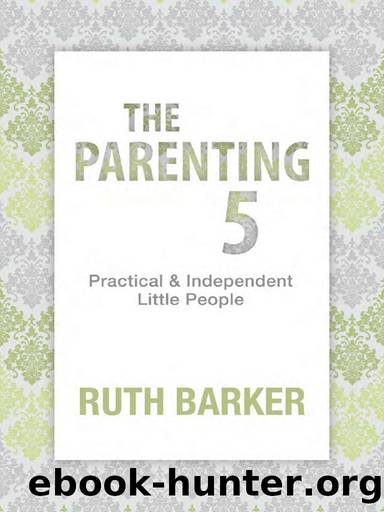The Parenting 5 by Ruth Barker

Author:Ruth Barker
Language: eng
Format: epub
ISBN: 9780992310370
Publisher: Toddler Education Services
Published: 2014-01-22T00:00:00+00:00
Chapter 3
MANAGING BEHAVIOUR IN THE ENVIRONMENT
The following is a useful plan when engaging with children at home or in the childcare setting:
⢠Provide a functional continuous routine where the same actions occur daily (with some flexibility) such as having the same bath and bed routine.
⢠Provide a beautifully designed space with child size furniture and ordered tools and activities.
⢠Decide on the beliefs, values and limits for behaviour.
⢠âStart as you mean to go onâ by clearly defining those beliefs, values and limits.
⢠Expect that children should respect the limits all the time, where no means no.
⢠Remind the children what the limits are in periods of calm or before the behaviour may happen.
⢠Ensure effective reciprocal communication by giving value to helping children express their needs and through listening carefully to them.
⢠Address the children at eye level by crouching low or sitting on a low chair (this is more respectful than lifting the children off their feet).
⢠Positively reinforce appropriate behaviour and ensure positive reinforcement occurs for what the children have done, rather than the product produced or the children themselves.
For example:
âThe dishes are super shiny today and stacked so nicelyâ
or
âI like the way your wet pants are in the basketâ
or
âYellow and blue make green on your painting!â
Instead of:
âYou are a good girl for doing the dishesâ
or
âYou are clever putting the pants in the basketâ
or
âWhat have you painted?â
⢠Clearly remind the children in a nicely spoken but firm tone, when behaviour is inappropriate.
For example:
âI am sorry but I canât help you when you use a loud voiceâ
or
âExcuse me but throwing isnât how we put things away, lets try againâ
⢠Accept negative emotions from the children as normal and if it is possible, discuss the scenario when all is calm.
⢠Use consequences sparingly and not for children under three and a half years of age, as their brain development is not advanced to understand this process.
⢠Consequences should not involve hurting or shaming children; removing the activity and time with the adult is consequence enough for the children under school age.
⢠Ensure that consequences match the developmental level and the situation that has occurred.
Examples of inappropriate consequences might be:
Sending a two year old into an abandoned space for not putting away an activity or spilling something
or
Yelling at a three year old for wetting their pants and punishing them
⢠In the event of a severe tantrum, be present to ensure that children are safe by removing any dangerous items from the vicinity and show ignorance to violence and screaming; the children will soon realise they will not receive a reaction and that tantrums serve very little purpose in getting their own way.
⢠Once the children have settled comfort them and discuss your feelings about the event and the expected beliefs, values and limits required, using simple and effective language.
For example:
âI understand you feel sad but hurting each other is not allowedâ
or
âWe use a small voice in our house even when we are angryâ
⢠Look for support from another adult and
Download
This site does not store any files on its server. We only index and link to content provided by other sites. Please contact the content providers to delete copyright contents if any and email us, we'll remove relevant links or contents immediately.
Doing It: Let's Talk About Sex... by Hannah Witton(9084)
Thirteen Reasons Why by Jay Asher(8461)
The Girl Without a Voice by Casey Watson(7607)
Should I Stay or Should I Go? by Ramani Durvasula(7435)
The Incest Diary by Anonymous(7425)
The Lost Art of Listening by Michael P. Nichols(7169)
The Leavers by Lisa Ko(6807)
The Space Between by Michelle L. Teichman(6579)
The Testaments by Margaret Atwood(6513)
The Four Agreements by Don Miguel Ruiz(6324)
Rich Dad Poor Dad by Robert T. Kiyosaki(6185)
The Rosie Project by Graeme Simsion(5845)
We Need to Talk by Celeste Headlee(5420)
Beartown by Fredrik Backman(5369)
Men In Love by Nancy Friday(4968)
Ego Is the Enemy by Ryan Holiday(4962)
Spare by Prince Harry The Duke of Sussex(4792)
Hunger by Roxane Gay(4681)
Suicide Notes by Michael Thomas Ford(4656)
